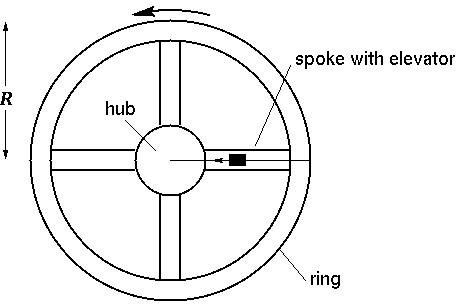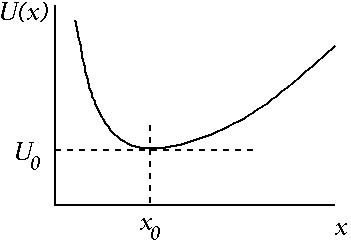Problem 3. En route to Tycho Magnetic Anomaly 1. A space station consists of a hub connected to a ring by four spokes. The whole station turns as a unit with period T to provide ``artificial gravity'' to the occupants, who, of course, walk around on the OUTER wall of the ring. Note: there is no real gravity in this problem. The spokes contain elevators to bring people and equipment to and from the docking port at the center of the hub.
 Assuming no friction and a massless elevator cable, how much work does
the elevator motor do in bringing a load of mass
M (including the elevator
car), slowly and at constant speed,
from the ring at radius R to the center of the hub?
Without regard to your detailed calculations, is this work positive, or
negative? Assume that the walls
of the spoke keep the elevator car turning around the
hub with period T
and with negligible effect on the rotation of the station as a whole.
Assuming no friction and a massless elevator cable, how much work does
the elevator motor do in bringing a load of mass
M (including the elevator
car), slowly and at constant speed,
from the ring at radius R to the center of the hub?
Without regard to your detailed calculations, is this work positive, or
negative? Assume that the walls
of the spoke keep the elevator car turning around the
hub with period T
and with negligible effect on the rotation of the station as a whole.
Warning: There is a strong temptation to use
W=delta K here. In this case, however, the walls of the
shaft
are doing the work that changes the speed of the car, not the elevator
motor.
Problem 4.
- a) The potential energy of an object is given by U(x)=8x2-x4, where U is in Joules and x is in meters. (a)Determine the force acting on this object. (b)At what positions is this object in equilibrium? (c)Which of these equilibrium positions are unstable?
- b) The figure shows a potential energy function U(x)
for motion in one dimension that is arbitrary except
for the fact that it has a stable equilibrium
point at x0.
Show that for small displacements from equilibrium, this system obeys
Hooke's Law, that is, it acts just like a mass on a spring. What is
the value of the "effective spring constant" k?
Hint: a Taylor series will tell you the behavior of U(x) near x=x0.
Note how general this is: for small displacements from equilibrium, (almost) everything acts like a simple spring! Given your derivation, can you think of an exception?

Problem 5.
-
K&K 2.34. However, please do not explicitly use the conservation of angular
momentum.